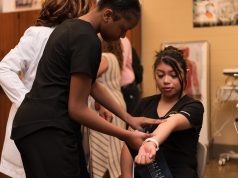By Samuetta Hill Drew
A couple of weeks ago, the safety article addressed a three part series on the creation of safety plans to fit the needs unique to your family and situation. The first segment in the series provided details on the “how to” of developing an Emergency Family Communication Plan. This week’s focus will be the formation of a Fire Escape Plan.
Your ability to get out of your home depends on advance warning from smoke alarms and advance planning. So let’s begin with the basics, which are making sure you have operable fire alarms installed in or near all your bedrooms, as well as on each level of any multi-level home. An unfinished basement should be included as one of your levels, if applicable. Interconnected smoke alarm system throughout your home provides additional safety because they will all sound when one alarm sounds.
Next gather all family members together and start making your Fire Escape Plan. Draw a map of your home showing all the different doors and windows. The map should have markings denoting how to exit each room. Each family member should have a copy of the plan in their bedroom. Visit each room to determine two ways to exit. If your doors or windows have security bars on them, make sure they have emergency release devices inside so they can be opened immediately. Emergency release devises will not compromise your security, but it will increase your ability to quickly escape a room safely. Pet owners should make provisions in the plan for your pets.
Choose an outside meeting location in front of your home. It should be a safe distance from the home. Make sure to mark the meeting location on your escape plan.
Check to make sure your house number can be easily seen from the street. If not, paint it on the curb or install house numbers so the emergency response unit can locate your home.
It has been reported that children often can’t hear fire alarms, so someone should be assigned to each child in your home in case of a fire. Someone should also be assigned to any infants, elderly and/or disabled family member with mobility issues. Have a back-up person assigned to each of these individuals just in case the designee is not at home.
Test your plan at least twice a year, both during the day and night. Be prepared to put your plan into action if the smoke detector alarms. Once out, do not reenter for any reason. Contact the fireman if someone is missing. They are trained to rescue individuals.
When you have houseguest, share the plan with them. If your children attend a “sleepover” ask the parents about their fire escape plan and share this information with your child.
At the end of the day, you want to be fully prepared with a plan and practice so you and your family can Keep an Eye on Safety in case of a fire.





